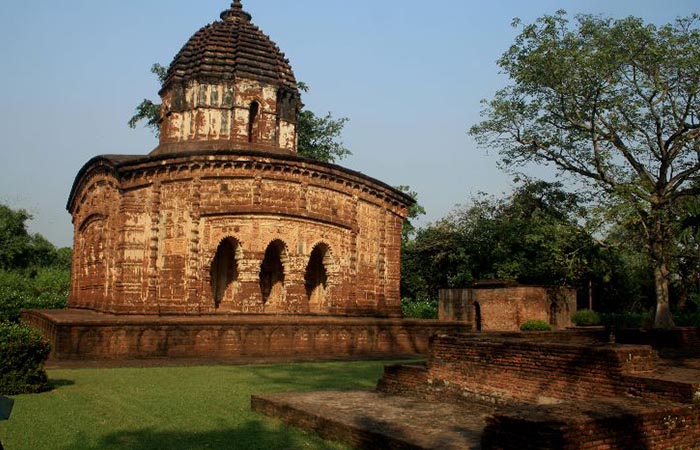
Located in the Bankhura District of West Bengal is a quaint town called Bishnupur or Vishnupur. It is known for its ancient temples dating back to 15th century. During Gupta era the land of Bishnupur was ruled by Malla rulers and it was known as Mallabhum. Bishnupur is also famous for its own Baluchari sarees made of tussar silk. Bishnupur with its terracotta building and regal past has become the paradise for travelers who want to explore the beauty of ancient India. There are many places in Bishnupur which showcases the intricate crafting skill of terracotta architecture.
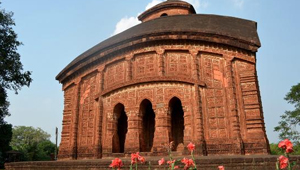
It is one of the prime attractions of Bishnupur which was built in 1655 A.D by Raghunath Singha, a Malla Ruler. Jorebangla Temple is known for its unique architectural style particularly for Bengal Region. The inner walls of Jorebangla Temple are adorned with the carvings which depicts many prominent Holy Scriptures like Ramayana, Mahabharata and other. This temple is mostly visited by the devotees and archeologists.
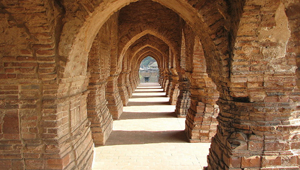
Built in 1600 C.E. under the commandment of Malla King, Vir Hambir is Rasmancha, one of the only kinds of its structure in the whole Bengal. It was a sacred temple built to mark the celebration of Ras festival where deities where brought from all the sanctuaries under the roof of this very Rasmancha to be worshipped by the villagers. This tradition has been discontinued since 1932. At present day Rasmancha is preserved by the Archeological Survey of India where visitors can admire the unique architectural style of this sanctum.
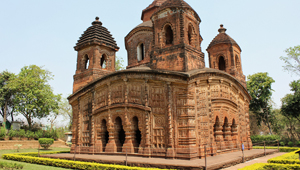
It is a 17th century terracotta temple located in the Bishnupur. Pancha Ratna Temple or Shyamrai Temple was built under the rule of King Raghunath Singh. The design of Pancha Ratna Temple was inspired by four different religions Muslim, Jain, Buddhism, and Hinduism and dedicated to Lord Krishna. The inner sanctum of Pancha Ratna Temple showcases the 8 avatars of Lords Krishna while depicting stories of different era like Ramayana and Mahabharata. Like most of the ancient temple Pancha Ratna Temple is also preserved by Archeological Survey of India.
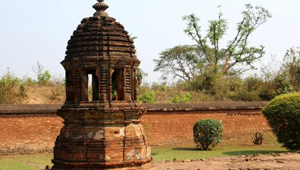
It is another ancient temple built in the 1729 A.D. by King Krishna Singha. Radha Govinda Temple is dedicated to the pair of Radha and Govinda. Made of mud and terracotta the structure of this ancient shrine resembles the multiple other temples built by the Malla kings during Gupta Era. The intricate craftsmanship of Radha Govinda Temple has fascinated many tourists visiting Bishnupur.
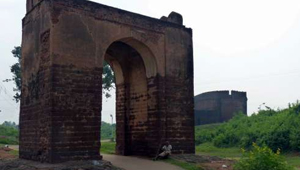
Located in the entrance of Bishnupur is the most iconic structure from ancient era The Gate of Old Fort. The fine arched gateway of Old Fort has a central passage for accommodating the Malla Troops. Visitors can see the Gate of Old Forts has small openings known as arrow slits made for gunmen and archers.
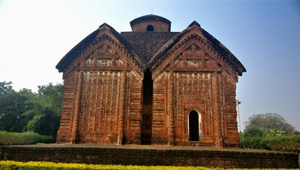
With its unique carving Sarbamangala Temple is another ancient structure which was built by a Malla Ruler. It is dedicated to Lord Krishna. Inside the temple visitors can see the craving depicting the stories of Mahabharata and Ramayana.
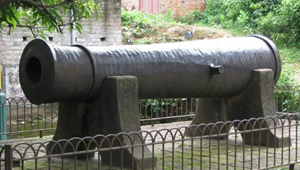
Discovered by British in 1919 after the downfall of Malla ruler is Dalmadal, the great royal canon. According to famous myth it is believed that Lord Madan mohan, another name of Lord Krishna, used Dalmadal Canon with his own hand to protect His city from the inroads of Maratha dacoits. So the local people respect the cannon which was touched and blessed by Lord Madan mohan. Till date Dalmadal is the sign of regal era when Malla rulers ruled the land of Bishnupur.
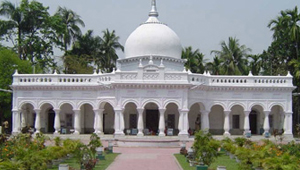
Built by Malla Ruler Durjana Singh Dev in the late 17th century is Madan Mohan Temple which is also known as Ek-ratna Temple. Dedicated to Lord Krishna Madan Mohan Temple is the largest and most renowned temple of Bishnupur. The interior of this largest sanctum is filled with the cravings depicting the life of Lord Krishna from the blissful memories of childhood to epic battle scene. Visitors on the base of pillars can notice the battle scene between Hanuman’s Army and Ravana’s Army from Ramayana.
October to March is the apt season to visit Bishnupur and explore and learn about the terracotta architectural style while relishing in the lingering essence of regal Gupta era.
Quick Enquiry